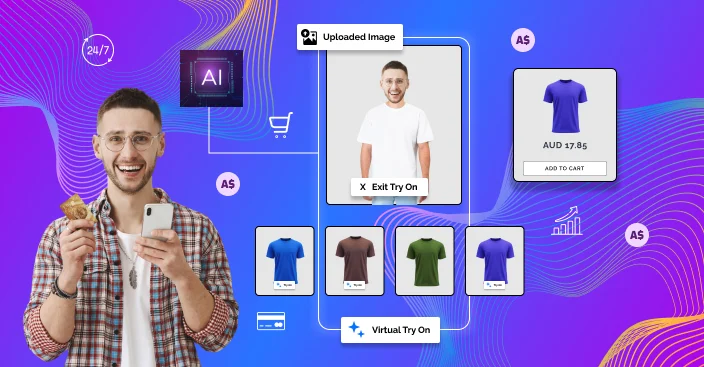AI-Powered Hyper-Personalisation and Beyond in Australia’s Future of Commerce

Table of Contents
In recent few years, AI has broken records for the eCommerce market in Australia. In different aspects, it has changed how buyers are doing shopping. With the help of Artificial intelligence, from smart logistics and real-time personalisation to predictive analysis, it’s completely reshaping how brands offer services to customers, sell to them, optimise operations, and grow.
With the Australian digital economy gearing up to hit AUD 250 billion by 2025, integrating AI into retail business is no longer a choice but a must-have. Along with this, the need for hyper-personalisation is also essential.
This article talks about the revolution of Australian eCommerce through the hyper-personalisation AIs with cutting-edge technologies, the challenges faced by companies, and the way ahead.
The State of Australian eCommerce
Before venturing into AI, it’s worth being awed by how far eCommerce has come in Australia.
There was a pandemic digital acceleration that saw online shopping balloon, buyers prefer to use online retail more, and that is initiating the use of key eCommerce platform, such as Shopify, BigCommerce, Magento, and WooCommerce remain market leaders, with biggies such as Myer, Woolworths, Kogan, and The Iconic still spending heavily on eCommerce innovation.
Marketers have discovered that the old website is no longer sufficient, though, as competition has grown. Customers are pushing brands to the limits of artificial intelligence by wanting online experiences that are simpler, easier, and more personalised.
What is Hyper-Personalisation?
Hyper-personalisation goes beyond segment marketing or recommendations. It uses real-time data, AI engines, and machine learning (ML) to craft an extremely individualised experience for each customer on the basis of their behaviour, interest, and requirement.
Instead of segmenting customers, AI enables brands to treat “segments of one” and make emails, product recommendations, prices, and even content more personalised in real-time.
Yes, and the following is the reformatted “Rise of AI in Australian eCommerce ” subsection with three short pointers, one in its own short paragraph format:
The Rise of AI in Australian eCommerce
Personalised Product Recommendations
Australian companies are being aided by AI-based recommendation sites in developing hyper-personalised shopping. Since they are able to access browsing history, historical purchases, and user profiles, sites such as The Iconic provide product suggestions that enhance engagement and purchases.
Catch.com.au, for instance, leverages real-time information to provide customers with suitable promotions, enjoying stratospheric conversion boosts and minimising cart abandonment.
Smart Search and Visual Recognition
Today’s consumers like to find products quickly and in one go while shopping online. AI makes that even better with smart search functions that can interpret natural language and even make precise predictions.
Visual recognition does the same—retailers such as Showpo enable users to upload a picture and discover substitute products in one go, providing an interactive and interactive shopping experience.
AI Chatbots and Virtual Assistants
Customer support assistants are getting smart and within reach with AI chatbots. Virtual assistance 24/7 gets to know Aussie slang and purchase intentions through Natural Language Processing (NLP).
Woolworths, for instance, has an AI assistant that handles order tracking, product details, and recipe recommendations, and leads to a seamless post-purchase experience.

Predictive Analytics
Artificial intelligence is revolutionising Australian eCommerce businesses’ approach to consumer behaviour prediction. With its capability of scanning humongous volumes of data, AI can predict future action, personalise interaction, and make business decisions on autopilot.
Inventory management happens to be one of the most dazzling tasks predictive analytics can accomplish. Companies such as the ones currently using AI to accurately predict demand, manage overstock and risk of stock-out, and stock store shelves with the correct product in the correct quantity at the correct time.
Dynamic Pricing
Dynamic pricing is another fine example. AI dynamically manages the price of products in real time based on several parameters like customer demand, competitive price, loyalty level, and market trends at a particular time. It relies upon revenue generation as well as customer satisfaction through competitive prices.
Other than that, AI helps calculate Customer Lifetime Value (CLV), which determines the high-value customers and enables companies to realign their marketing strategy accordingly.
For example, an Australian pet shop owner used AI to scan seasonal shopping habits. Later, they re-optimised inventory, optimised delivery time, and minimised product wastage significantly.
AI in Logistics and Fulfilment
Aside from its application in storefronts, AI also participates in order fulfilment and optimisation of logistics. Geography in Australia demands cost-effective delivery infrastructures as it is big.
AI route optimisation designs the best and shortest route to deliver in a bid to save costs and enhance customer satisfaction. In the warehouse, AI robots and automation attain optimal productivity with speed and accuracy in picking, packing, and sorting.
Along with this comes drone deliveries with AI, with Alphabet subsidiary Wing already testing in some areas of Australia. All such technologies guarantee faster, more precise, and cleaner ordering and delivery.
Voice Commerce and Conversational AI
With home automation technology going mainstream in Australia, voice commerce is rapidly becoming the new retail frontier. With Google Nest and Amazon Echo, one can search for things, order, or check delivery status through voice commands.
The stores are also keeping up and doing the same in order to make all this simple and convenient for customers.
For example, Coles is Google Assistant-enabled now, where customers can add products to their shopping list through voice command, making the entire experience convenient.
AI-Driven Fraud Detection
Large internet payments are accompanied by the danger of internet fraud. AI precludes this through monitoring customer behaviour continuously and analysing suspected patterns. It identifies suspicious patterns in transaction behaviour, recognises suspicious accounts, and inhibits real-time fraudulent chargebacks.
Australian online companies that have used AI-based fraud prevention software have witnessed an incredible reduction, 30% to 50%, of fraud.
Not only is revenue protected, but customer trust is also boosted, along with the control of Australia’s data privacy legislation, such as the Privacy Act 1988 (Cth).
Australian eCommerce Challenges of Using AI
Data Privacy and Compliance
As more value is being assigned to data privacy and top-level hacks like those that have been conducted by Optus and Medibank, Australian online companies need to be highly careful with how they gather, keep, and use customers’ data.
Regulations like the Privacy Act 1988 (Cth) are also a limitation to the use of AI personalisation technology.
Talent and Skill Gaps
There is not enough AI, machine learning, and data science talent in Australia. Not enough of these skills exist and are holding most organisations back from hiring or keeping the people they need to implement and operate AI systems properly.
The other choice is to reskill current teams, which will be an investment of money, time, and cultural change to digitalise.
Integration Complexities
AI deployment typically entails a great deal of integration with existing platforms and databases. Firms with dated platforms or outdated technology stacks find it hard to deploy AI software optimised for their firms.
For the majority of small-to-mid-size retailers, it’s an economic issue as much as a technical issue to integrate AI in legacy applications.
Adoption is too expensive, especially in infrastructure, software, man-hours, and upkeep. Even when the final advantage breaks even in the long term, initial investment may prevent small enterprises from adoption, especially with no evident motivation to return ROI.
What’s Next for AI in eCommerce
Emotion AI
Ultimately, human emotions will be detected by artificial intelligence software from tone of voice, facial expressions, and web activity.
Artificial intelligence technology will allow web business firms to tailor experiences in real time, giving thoughtful and judicious answers to shoppers’ moods as they shop or even interact with their sites.
AR and AI Integration
The blending of Tech-Augmented Reality and Artificial Intelligence (AI) will provide enhanced online consumer shopping through interaction-based product offerings.
Customers are able to try dresses virtually, test home furniture products in their homes, or try makeup products all on their devices.
Australian retailer Mecca is already piloting AI-powered virtual try-on capabilities to connect customers more substantively. Ethical AI and Transparency are essential.
For ethical consumers, more than ever, transparency in how the AI systems function would be called for.
eCommerce would require their AI models to be open, transparent, and fair, particularly in high-stakes categories such as price, product visibility, and customer segmentation.

Unified Commerce Platforms
The retail future is unified commerce, and AI brings to life the imbalance between social media, stores, mobile apps, and websites.
By employing AI to bring together the data and personalising each touchpoint on every channel, organisations can provide seamless, unified customer experiences anywhere.
How Australian eCommerce Companies Can Prepare
To achieve maximum benefits from AI, eCommerce business organisations need to take the following strategic steps:
Begin with the Customer
Use AI to map pain points, tailor the experience, and create delight via touchpoints.
Invest in the Correct Solutions
Connect with AI providers, who have experience in retail industry, let them implement most useful options like AI recommendation engines, virtual assistants, and forecasting analytics.
Upskill and Educate
Send your staff and upskill them to embrace AI by investing in digital transformation and data literacy training initiatives.
Ensure Ethical Data Practices
Gather and use data in a responsible, compliant, and transparent way, as a matter and ethos to be implemented in all AI projects.
Final Thought
The future of Australian online shopping powered by AI is a fait accompli. Personalisation for improved business performance, security of transactions, to identifying patterns – AI brings businesses from reactive sellers to proactive experience creators.
As Australian consumers become more digitally literate, pressure will only mount. It’s those companies who use AI responsibly, who know how to innovate but not how to behave ethically, how to tailor but not how to honour privacy, who will not only keep up but thrive in next-economy AI.
It is now time for Australian online businesses to accept artificial intelligence to ensure the future of online shopping.Get in touch with our Sydney-based retail specialists for a better experience and a smooth commercial conclusion.
FAQs
 How is AI changing the way buyers shop online?
How is AI changing the way buyers shop online?
AI is having the most powerful options; it can help to personalise the online shopping experience with proactive recommendations, smart search, ongoing live chat support, and suggestions based on user behaviour.
 Is AI reserved for large Australian retailers, or will small retailers also be invited to utilise it as well?
Is AI reserved for large Australian retailers, or will small retailers also be invited to utilise it as well?
AI is available for any company size. There are several tools and platforms that provide scalable AI solutions in a manner that small retailers can design customer engagement, automate processes, and remain competitive.
 What exactly is eCommerce hyper-personalisation, and why would retailers need it?
What exactly is eCommerce hyper-personalisation, and why would retailers need it?
Hyper-personalisation is a useful feature for delivering real-time data and AI to create highly personalised shopping experiences with the goal of boosting your business conversion, user loyalty, to ensuring higher user expectations.
 How are eCommerce businesses measuring their AI ROI?
How are eCommerce businesses measuring their AI ROI?
There is space to be measuring ROI in terms of such key performance metrics as higher conversion rates, higher average order value, lower cart abandonment, improved customer retention, and productivity
 In what ways is AI empowering Australia's sustainable eCommerce?
In what ways is AI empowering Australia's sustainable eCommerce?
AI avoids wastage by minimising inventories through wiser management, minimises emission-based modes of delivery and promotes green consumption through its impact on eco-products.



